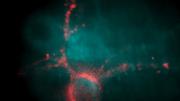A new tool developed in the lab of Adam Cohen, Loeb associate professor of the natural sciences, may illuminate neuroscience research: it allows neurons to light up as they fire. “For decades, people have wanted a way to look at a neuron and tell what it’s doing,” Cohen says. But just as we can’t see electricity coursing through a telephone wire, there’s been no good way to watch electrical signals move across neurons.
Until now. Cohen’s team used a protein from a Dead Sea microorganism that normally absorbs sunlight and converts it into electricity. “A few years ago, I wondered if it was possible to run [similar proteins] in reverse,” he says, “so instead of taking in light and generating electricity, we could use it to sense electrical energy in a cell and convert that into a detectable optical signal.” MIT researcher Ed Boyden recently conducted research that involved placing the gene that expresses this protein in an animal neuron, and he shared the gene with Cohen.
Cohen’s team genetically modified a virus to carry the gene, and then used the virus to infect rat neurons. Once inside a neuron, the gene prompts production of these proteins, which settle in the cell membrane. There they act like microscopic voltmeters, monitoring voltage changes. When a neuron is at rest, the inside of the cell is electrically negative compared to the outside, keeping the protein “dark.” But when a neuron fires, it causes a brief voltage spike that reverses the charge, prompting the protein to light up.
Although Cohen has already shared them with more than 60 labs, these voltage-indicator proteins aren’t ready for wide use yet, he says. The flashes are infrared and invisible to the naked eye, so Cohen’s team has had to develop specialized optical equipment to see them, and it will take other labs some time to set up similar equipment. “The neuroscientist’s dream,” he explains, “is to look into a brain and see all the neurons firing,” which would allow researchers to watch how signals spread, and even to see whether the speed at which they move is modulated by learning. “But we need to make our indicator brighter for that to work.”
Cohen believes the proteins have a range of additional applications as well. They could help test new drugs, for example: his team has added the voltage indicators to cardiac cells, which would allow them to study the effect of new medications on signaling in the heart. The fact that scientists would see the results through a microscope, he says, could dramatically increase the speed of drug testing.









